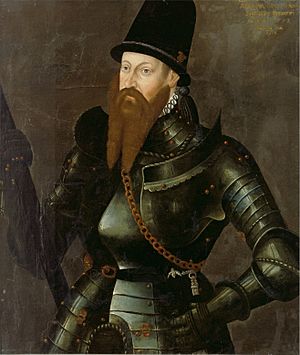Albert Alcibiades, Margrave of Brandenburg-Kulmbach facts for kids
Albert II (born March 28, 1522 – died January 8, 1557) was a ruler known as the Margrave of Brandenburg-Kulmbach from 1527 to 1553. A margrave was a type of count or ruler in the Holy Roman Empire. Albert was part of the Hohenzollern family, a powerful German noble family. Because he loved to fight and was very warlike, people called him Bellator, which means "the Warlike." After he died, he also became known as Alcibiades.
Quick facts for kids Albert Alcibiades |
|
|---|---|
| Margrave of Brandenburg-Kulmbach | |

Albert Alcibiades, Margrave of Brandenburg-Kulmbach
|
|
| Margrave of Brandenburg-Kulmbach | |
| Reign | 1527–1553 |
| Predecessor | Casimir |
| Successor | George Frederick |
| Born | 28 March 1522 Ansbach |
| Died | 8 January 1557 (aged 34) Pforzheim |
| House | House of Hohenzollern |
| Father | Casimir, Margrave of Brandenburg-Bayreuth |
| Mother | Susanna of Bavaria |
Contents
Life Story of Albert Alcibiades
Early Life and Becoming a Ruler
Albert was born in Ansbach. When he was only five years old, his father, Casimir, passed away in 1527. After his father's death, Albert was looked after by his uncle, George. His uncle George was a strong supporter of Protestantism, a new branch of Christianity at the time.
In 1541, Albert received Bayreuth as his share of the family's lands. The main town of his area was Kulmbach. This is why he is sometimes called the Margrave of Brandenburg-Kulmbach.
A Military Career Begins
Albert had a very active and restless personality. This made him well-suited for a life in the military. He gathered a small group of soldiers. In 1543, he helped Emperor Charles V in his war against France.
The war ended in September 1544 with the Peace of Crépy. This meant Albert no longer had a job fighting. However, he had gained a good reputation as a soldier. When Emperor Charles V was getting ready to fight the Schmalkaldic League, he wanted Albert's help. The Schmalkaldic League was a group of Protestant princes who opposed the Emperor.
Battles and Changing Sides
Albert joined the Emperor's attack on the Electorate of Saxony. An Elector was a powerful prince who helped choose the Holy Roman Emperor. In March 1547, Albert was captured by John Frederick, the Elector of Saxony. But he was soon set free. This happened because the Emperor won a big battle called the Battle of Mühlberg in April.
After this, Albert became friends with Maurice, another Elector of Saxony. Albert then left the Emperor's side. He joined a group of princes who wanted to overthrow the Emperor. They even made an alliance with King Henry II of France.
The Second Margrave War
Albert took part in the fighting that followed. But when the Peace of Passau was signed in August 1552, he left his allies. He started taking things and money from towns in Franconia. This led to a conflict known as the Second Margrave War.
He forced the people of Nuremberg to give him a lot of money. Then, he had a disagreement with the French King, who had been his supporter. So, Albert offered his fighting skills to the Emperor again.
Emperor Charles V was eager to have such a skilled fighter on his side. He agreed to Albert's demands. The Emperor even allowed Albert to keep lands he had taken from the bishops of Würzburg and Bamberg. Albert showed great bravery during the Emperor's retreat from the Siege of Metz in January 1553. This was very helpful to the Emperor.
Final Defeat and Death
A few weeks later, Emperor Charles V left Germany. Albert then started taking things from towns in Franconia again. His actions became so serious that a group was formed to stop him. Maurice of Saxony, Albert's former friend, led an army against him.
The two armies met at Sievershausen on July 9, 1553. The battle was very fierce, and Albert's army was defeated. He had to run away. Henry, Duke of Brunswick-Wolfenbüttel, then took charge of the group's troops. In December 1553, Albert was officially banned from the Holy Roman Empire. He was defeated by Duke Henry and forced to flee to France.
In France, he joined the service of King Henry II. Albert planned a campaign to get his lands back. However, he died in Pforzheim on January 8, 1557. He was buried at Heilsbronn Münster.
Images for kids


